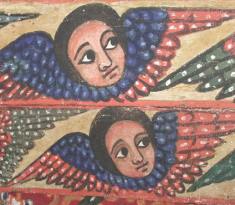The Living with gods: peoples, places and worlds beyond exhibition is at the British Museum until 8 April - I found some wonderful objects there, filled a page of my little notebook with visual reminders -
and couldn't resist taking a photo of the setup of the exhibition - swathes of translucent fabric marking off the sections. As you tried the look through, the shapes beyond were simplified and made mysterious. It seems to be a metaphor for the subject matter of the show.
The podcasts of the 30 programmes, made by Neil Macgregor, about some of the objects, broadcast last year, are available here or via various podcast services. I haven't heard them yet but will start listening immediately.
I didn't read all the labels or wall texts, so it's good to find a (large print) pdf of those online.
The little drawings and the notes are reminders to research some of the objects. This is enjoyable but takes up great chunks of time! This exhibition obviously had lots of unusual things in it, because my researches haven't produced images for some of the objects that caught my eye.
For example, Ethiopian angels are often shown with head and wings in an open configuration -

but those on a censer looked to be hugging a secret to themselves -
But were any similar images, wings folded plus head, to be found on the internet? (no)
My favourite object - too quickly drawn - was the group of protective female ancestor spirits from western Siberia, made by Teleut (a turkic people of the Altai) and kept in wooden containers as guardians. "Older women who have
survived childbirth are considered wise and
can help the young" says the label.
The coarse cotton has turned brown, the flimsy red cotton of the "dresses" had faded and was stained with the food these "grandmothers" have been given [they need to be taken care of and fed regularly to be worthy of the spirits' benevolence], and some patching was necessary, long ago (early 20th century).
They are very simple objects, just stuffed tubes and a couple of black beads for the eyes. Was it the group of three (cf. three graces...) that made them so resonant?
Also from Siberia, but in the east, is the "healing spirit doll's house" - "These dolls set up in a wooden-box home
are made by Ulchis people of eastern Siberia.
They are placed in the houses of seriously ill
people to help them recover."
It's a shallow wooden box, doors held on with string hinges ... inside are "flagpoles" and two dressed wooden figures with big blue eyes. At the top of the house, the flagpoles extend to finials at the top of the box. The figures, undressed, would look rather like these (with more attention to the eyes!), which are made by the Nanai, who together with the Ulchis call themselves the Nanay, "the people of this land" -
 |
| (via) |
From Japan, the "fox on a box" - "The fox is a spirit messenger for Inari, the
important Shinto deity for rice, harvests, trade
and prosperity. This porcelain fox has a key for
a rice store on its chest. The stopper on its head
represents a wish-fulfilling jewel. The fox spirit
delivers paper prayers, placed inside, to Inari."
 |
| Not the one in the exhibition, even though this site suggests it is |
The geometry of Ethiopian processional crosses, with their intricate latticework, has always fascinated me - one day I'll use it in a design...
 |
| (this and more here) |
Another useful bit of symbolism, on a Chinese flower pot, are the lotus flowers in cloud form, which communicate "may your wish be granted". An image of a similar flower seems impossible to find.
From Japan's Ainu people, whispering sticks, inau - of which there are several kinds. I was fascinated by how the long thin strips of curling wood have been shaved from the body of the stick.
Interestingly, a whispering stick appears among the carved figures in this still from the Nanay video -





No comments:
Post a Comment